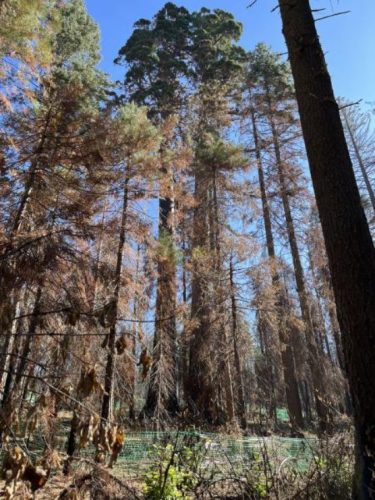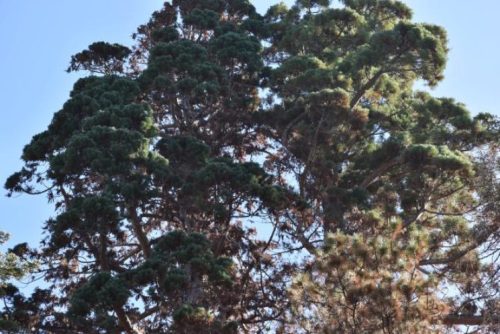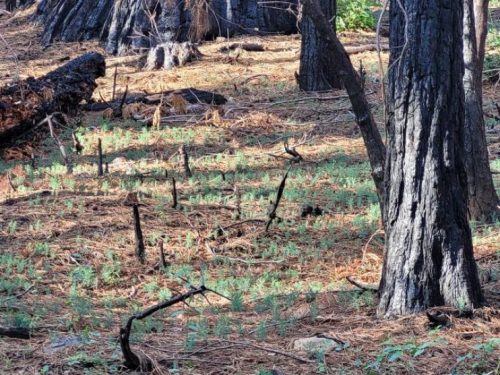
Calaveras Big Trees State Park planning more fuels treatment and prescribed fire in Giant Sequoia Groves; Update on status of the Orphans scorched by prescribed burning; Big step to increase the use of Beneficial Fire
The Calaveras Big Trees State Park Staff are using proven science-based methods to restore ecosystem function and reduce the susceptibility from severe wildfires to the Giant Sequoia groves in their care. By using vegetation treatments followed by prescribed fire to reduce the Century and a half of accumulated flammable forest material, the State Park Staff coupled with CAL FIRE’s beneficial fire expertise, are clearly needed actions, and a major step to reduce the threat of uncharacteristic severe wildfires. Their management actions are based on lessons learned when nearly twenty percent of Earth’s largest trees burned alive. That is close to 14,000 giant sequoia trees larger than four feet in diameter killed on six different wildfires between 2015 to 2021.
This is part of a heroic effort across the Giant Sequoia ecosystem in California and demonstrated here at Calaveras Big Trees State Park, where State Park Staff and CAL FIRE attempt to protect these giant sequoia groves by using fuels treatments and prescribed fire. It should be obvious to everyone with their head out of the sand, the risk of “no action” is unacceptable as demonstrated by the sacrifice of the 14,000 Giant Sequoia trees already consumed. The State Park Staff and CAL FIRE understand it is not just the giant sequoia groves that will benefit, the surrounding Communities along the Highway 4 corridor and forest ecosystems will also benefit from this pioneering effort to reduce the threat from uncharacteristic severe wildfires. Most importantly, this is not a “one-and-done” effort, it is a new beginning for California learning to live in a wildfire environment by accepting periotic use of beneficial fire.

On average beneficial fire reintroduction needs to occur once every 7 to 15 years, contingent upon available personnel, favorable weather conditions and forecasted smoke dispersing winds.
Update on the Orphans. In the Fall of 2022, the Calaveras State Park Staff and CAL FIRE began the prescribed burning process on 180 acres of the North Grove which contains the Orphans. During prescribed burning operations the Orphans received a heat pulse from the prescribed burn that blacken the tree’s bark and scorch the lower limbs of the canopies of both trees, one tree more than the other. The resultant heat pulse triggered the Orphans seed cones to open and shower the surrounding area with thousands of seeds. Recent photos show both trees have a healthy green canopy and huge trunks are surrounded by thousands of offspring.
In response to the shared concern of these two Icons, the Calaveras Big Trees State Park Officials have invited a Scientific Team of Giant Sequoia Experts to evaluate, assess health and the welfare of these two Iconic Giant Sequoia trees named “The Orphans.”

9/23 Photo by James Suero
On October 5, the Team of Giant Sequoia experts conducted their review. The Team agreed in the field, and have provided their opinion on the fire effects: “Given the amount of green canopy left on both trees, that it is extremely unlikely that either tree will die from the fire effects seen in the trees canopies.” As you know, giant sequoias can sustain 85-95% crown scorch and still survive. These trees show much less than that. We all agreed that the most likely outcome is that both trees will survive. There is also very good regeneration in this local hotspot which is great news. And finally, even though these trees will survive, we should anticipate that individual large sequoia trees may die even in the most careful prescribed fire. Having fire getting into or undermine a very old sequoia is one of the ways that these trees die naturally.”
One might think these beneficial fire efforts are uniquely Californian, springing from documents like the soon to be updated 2022 California Strategic Plan for Expanding the Use of Beneficial Fire, or prescribed burns funded through a grant from CAL FIRE’s California Climate Investments Program in partnership with Save the Redwoods League, or The Giant Sequoia Forest Resilience Project as part of California Climate Investments, a statewide program funded by billions of Cap-and-trade dollars. But now there is a new level of support for beneficial fire.

In the face of this national challenge, Congress took bipartisan action to establish the Wildland Fire Mitigation and Management Commission through the 2021 Infrastructure Investment and Jobs Act (Pub. L. No. 117-58; § 40803, 135 Stat. 1097 (2021)). From the Conclusion section of the WFMMC Full Report
“At the direction of Congress, the Wildland Fire Mitigation and Management Commission brought together a rare diversity of backgrounds, experiences, and expertise to address the wildfire crisis. The resulting recommendations reflect one of the most sweeping and comprehensive reviews of the wildfire system to date. Throughout its deliberations, the Commission sought to address the wildfire system holistically, with a goal of creating communities and landscapes that are resilient to wildfire as a natural and integral part of our nation’s future. While the resulting recommendations are extensive and diverse, they are also complementary and interrelated.
Across these recommendations, several themes emerged, including the need for immediate action and investment at a scale commensurate with the crisis at hand; the need to enhance and expand proactive mitigation in both the built and natural environment; the need to utilize science, data, and technology to inform our decisions for the best outcomes possible; and the need to embrace beneficial fire and prepare communities to live with it. An expanded and diverse workforce, inclusive and accountable governance systems, and greater collaboration and coordination across agencies, governments, scales, and sectors are needed to ensure everyone affected by wildfire is empowered to be part of the solution.
Rather than selecting one or more potential recommendations to carry forward for implementation, the Commission urges audiences of this report to take an “all of the above” approach. There is no single solution to the wildfire crisis; the scale of the issues necessitates solutions that are integrated, comprehensive, and broad in scope. The urgency of this need cannot be overstated. Severe wildfires are creating overwhelming losses, damages, and costs to communities and ecosystems across the country. The solutions are in hand, it is now incumbent upon us all to act upon them.”
Given the unprecedented scale and intensity of recent wildfires in California one might ask have we finally hit rock bottom watching our homes, our businesses, our wildlands and national treasures incinerate before our eyes in the haze of uncharacteristically severe wildfires? I would say an empathetic NO! With these important collaborative, science-based efforts underway, it is finally our chance to begin living in a wildfire adapted environment, where we plan and implement beneficial fire on the landscape at natural intervals and scales. If we all pitch-in and work together towards the common goal of living with fire, then maybe we can become better stewards of this land, a lesson we need to learn from the first land stewards of this great Country- the Native American Indian.
Craig Thomas, Director
The Fire Restoration Group
Brent J. Skaggs, Contractor
The Fire Restoration Group
